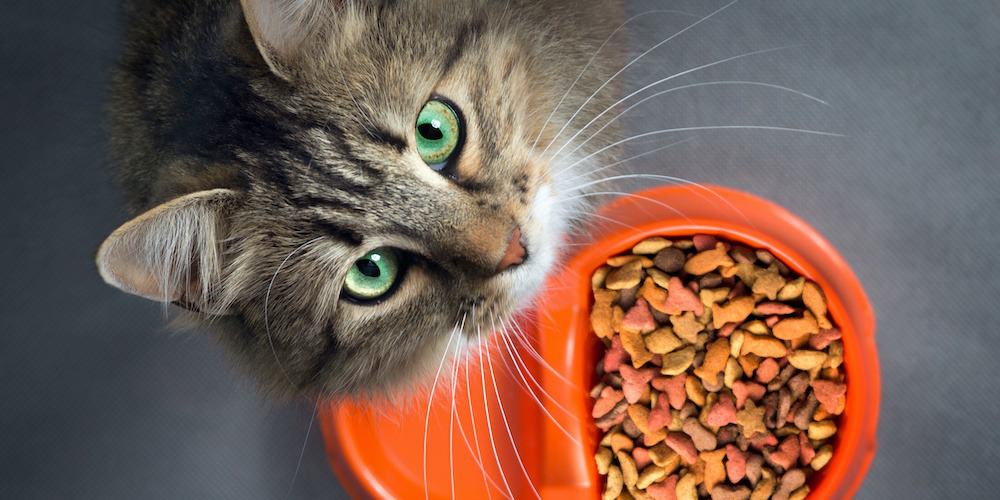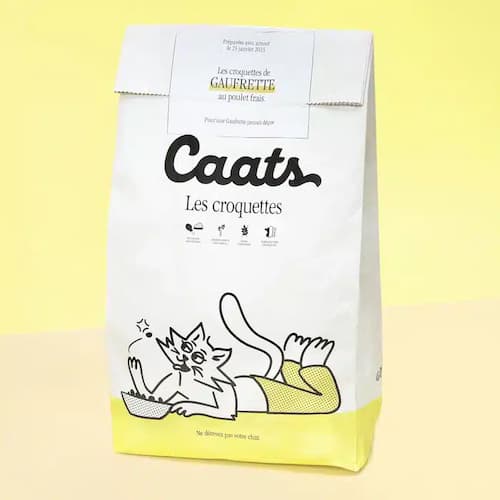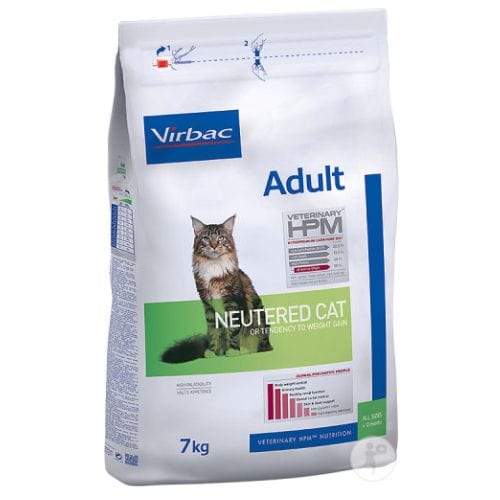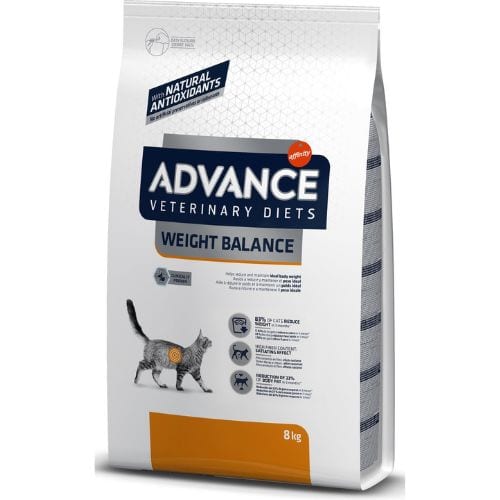Summary of My Selection
Best Value for Money 🥇
> Kibbles for Adult Sterilized or Indoor Cats – Ultra Premium
Best Premium Cat Kibbles
> Sterilized Cat Kibbles – Franklin
Best Customized Cat Kibbles
> Customized Kibbles – Caats
The importance of nutrition for health is no longer in question. Combined with a satisfactory lifestyle, it ensures a long and healthy life, both for humans and cats. For a long time, industrial foods, particularly kibbles, have been favored by pet owners.
Convenient, complete, safe (notably thanks to their cooking method and low water content), anti-tartar, cat kibbles indeed have many advantages. In addition, their crunchiness is adored by many animals.
But in recent years, brands have multiplied, boasting their merits with prominent chicken fillets or fresh peas printed on shiny packaging. Yes, indeed, 15 million cats in France attract attention…
Therefore, it’s difficult for the average person to make the right choice. Because marketing is fine, but for Réglisse or Plume, a good PPC (Protein/Phosphorus Ratio, see further in the article) is better!
We evaluate all products independently. If you click on one of the proposed links, we may receive a commission, which does not affect the price or ranking.
A Very Carnivorous Little Feline…
Cats have specific nutritional needs. Firstly, they are obligate carnivores, unlike dogs who are more omnivorous. This doesn’t mean they eat only meat, but that proteins (especially those of animal origin, namely from meat, fish, or eggs) must form a predominant part of their diet.
They also have specific needs for certain amino acids (protein components) like taurine, which is absent from plant proteins. Additionally, cats have weaknesses: their kidneys and urinary system, which need to be preserved.
… and Prone to Overweight
In France, the vast majority of male cats are neutered, and females are spayed. Such sterilization has consequences on the body’s metabolism: appetite increases, fat accumulates. Our sterilized cats are predisposed to weight gain.
This, if not monitored and if the animal is sedentary, can lead to obesity. As with humans, overweight promotes the development of numerous pathologies like diabetes, osteoarthritis, hepatic lipidosis… It is estimated that the energy needs of a sterilized cat are about 20% lower than that of an intact animal. This should be considered in the formulation of dry foods intended for this feline population.
How to Find the Right Kibble? The one that best meets the needs of a sterilized cat? To navigate the pet food market, with Darwin Nutrition, I provide this comparison of a sample of 19 brands. This article will also give you clues to find the best kibble through label decoding.
Best Kibbles: Our Opinion
With Darwin Nutrition, we have ranked the 19 kibbles studied. Here is the list, overall and according to specific criteria.
This is a ranking based on objective criteria, according to current knowledge of feline nutrition, but which of course only pertains to the kibbles selected for this comparison. Other foods not studied here are certainly excellent products.
NB: Prices are given as an indication; they may vary from site to site and depending on promotions.
Brands Compared: Advance, Brekkies, Caats, Edgar Cooper, Eukanuba, Franklin, Hill’s, Iams, Lifelong, Nature’s Variety, Orijen, Purina One, Purina Pro Plan, Ultra Premium, Virbac, Wellness Core, Whiskas, Ziggy.
# Best Value for Money 🥇
Ultra premium direct – Grain-Free Kibbles for Adult Sterilized or Indoor Cats
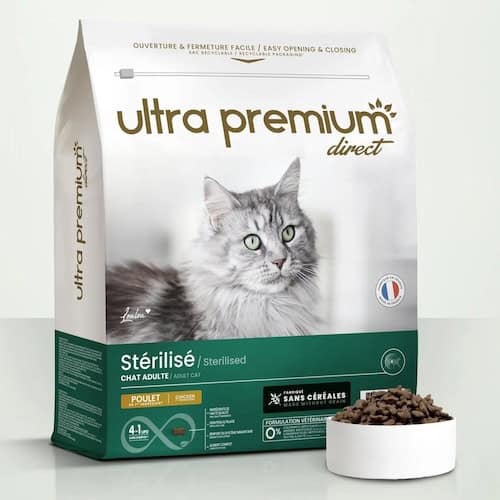
Rating: 4.4/5
Nutrition : ★★★★☆
Sécurité : ★★★★☆
Marque : ★★★★★
Advantages
- Proteins OK
- The best brand rating
- No middleman for cost reduction
- Made in Lot and Garonne
Cons
- A bit low fiber rate for a light kibble (2%)
- Non-veterinary brand
The 183,000 followers of the Ultra Premium Direct brand certainly won’t speak ill of it, as they’ve given it a score of 4.7/5!
With a more than satisfactory composition, these kibbles offer the best value for money in our panel (€9.60 per kilo when ordering from the brand’s website, €8.66 with a subscription in 2024). An interesting compromise for tight budgets in these times of inflation.
The Ultra Premium Direct kibbles contain 43% protein, 23% carbohydrates, 15% fats. They are produced in France from ingredients sourced from the European Union. The brand is a member of FACCO, which guarantees compliance with animal feed regulations.
And for those allergic to online orders, Ultra Premium has also opened stores in various cities in France; the latest one just opened in Normandy (Hérouville).
Price: €28.90 for a 3 kg bag
# Best Premium Cat Kibbles
Franklin – Grain-free cat kibbles
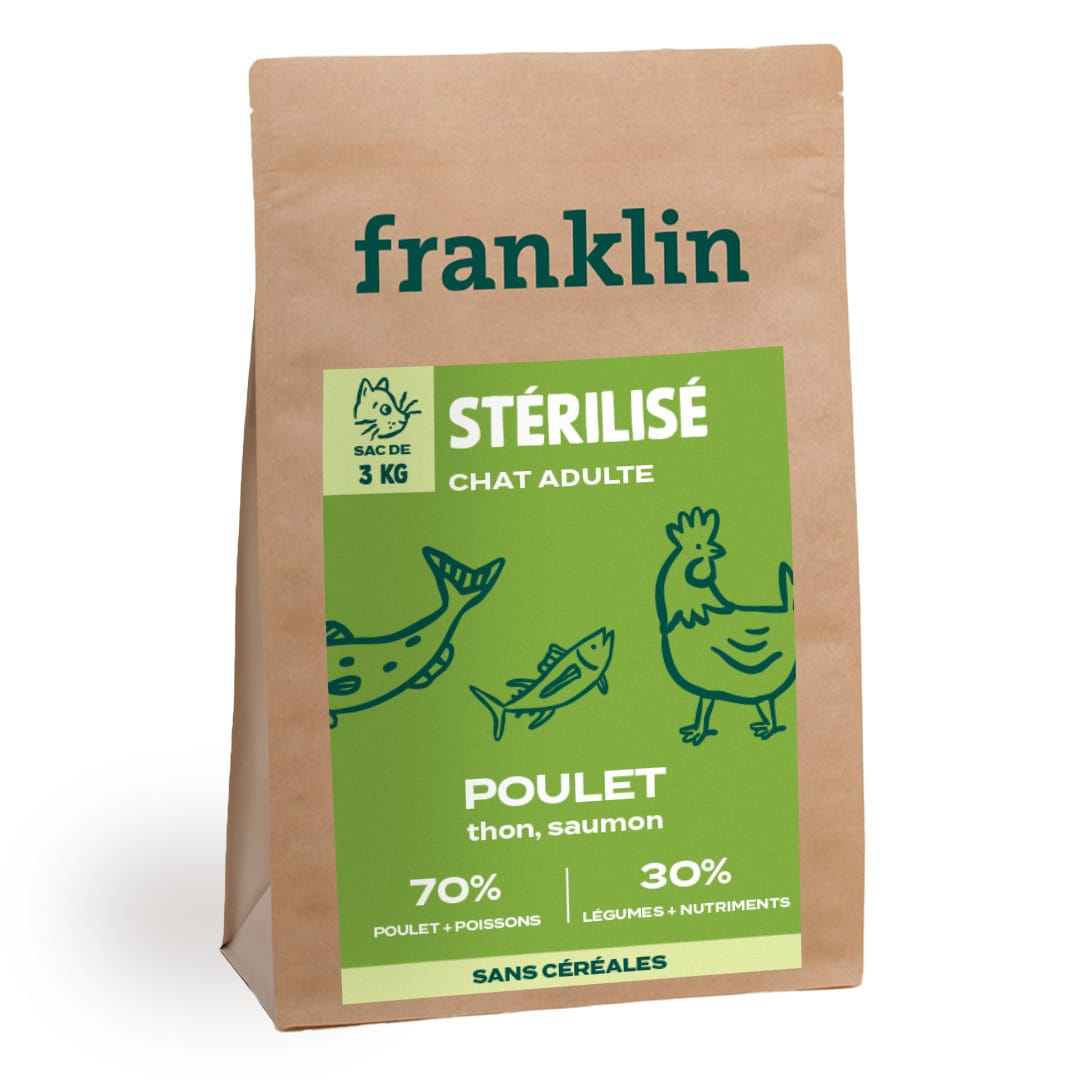
Rating: 4.4/5
Nutrition : ★★★★☆
Sécurité : ★★★★☆
Marque : ★★★★★
Pros
- Good nutrition rating
- Excellent value for money
- Low calorie
- A French brand
Cons
- Not the highest RPC in the comparison
- Made in the EU, not France
Franklin is a small brand on the rise (already 22,000 followers!). Created in 2018 by two cat and dog lovers, the company is based in Paris. They are among the pioneers of single-protein kibbles for the most sensitive cats. It offers a very interesting value for money with quality products at a reasonable price.
The kibbles we selected are based on chicken and salmon proteins (70% of the ingredients). They are among the lowest in fat in the panel, with an 11% fat content and 355 kcal / 100 g. They also contain omega 3 fatty acids for heart and skin health, vitamins, and minerals.
Franklin kibbles are made in the Czech Republic. The brand is rated 4.7/5 on Trustpilot, indicating genuine customer satisfaction. There’s also a very responsive customer service (email responses within half a day!).
Price: €31.90 for a 3 kg bag
# Best Personalized Cat Kibbles
Caats – Personalized kibbles
Pros
- Percentage, protein origin, RPC, and price-performance ratio at the top
- Almost infinitely customizable
- Made in Vendée
- Ability to see the composition of kibbles before ordering
Cons
- A slightly high fat content (15%)
- The price of premium kibbles (discount available from 2 cats)
Launched by veterinarian Jean-Marc Denoun, Caats is a small brand developing by surfing on the custom-made trend.
To evaluate Caats, I created the profile of “Riton”, a 6-year-old neutered male cat; I then filled out a questionnaire on his age, breed, body condition, physical activity (none!), and health issues (arthritis, kidney failure, urinary stones, digestive problems, allergies…). I immediately accessed the recommended kibbles’ characteristics for Riton, and everything checked out (41% protein, 21.5% carbohydrates, 8% ash, and 4.5% fiber). One more click and you receive your trial kit.
Subscription option to avoid having to think about it, a real bonus for an overbooked human. Note, if your pet has a chronic illness, their personalized kibble does not replace a veterinary consultation.
A responsive brand. Sometimes a bit too much. If you’re allergic to insistent marketing, look elsewhere. Founded in 2020, Caats already has 79,000 followers and boasts a ‘good rating’ online.
Price: 29.70€ for a 3 kg bag
# Best kibble for neutered cats from a veterinary brand
Virbac HPM – Adult neutered cat kibble
Advantages
- 44% protein, 90% from animal sources (pork and poultry)
- A recognized French veterinary brand
- Results on feline health substantiated by scientific studies, with 36 communications supporting this
- Rich in fiber
Disadvantages
- Packaging is in English and doesn’t really attract
- The cost of (very) high-end kibble
Cocorico! It’s yet another French kibble (made in Camargue) that stands out! The HPM range (for Hyper-Premium) is developed by veterinary nutritionists and benefits from all the guarantees of a veterinary brand. The Virbac group, created in 1968 by Pierre-Richard Dick, is a heavyweight in animal health with ranges of medicines, hygiene products, and foodstuffs.
Well-balanced kibble, low in carbohydrates (20.5%) and rich in fiber (8%) for better digestive comfort and satiety; a high fiber content that should not come at the expense of stool quality (possible in some sensitive animals).
Virbac HPM kibble suffers from a slight lack of notoriety (5282 followers); they can be found in veterinary clinics or on the sites of these clinics and pet shops. A technical kibble therefore, to be discovered, which brings veterinary quality and security with the same standards as human food. Buy with confidence!
Price: 35.95€ for a 1.5 kg bag
# Best kibble for overweight cats
Advance – Veterinary diets, Weight balance
Advantages
- The lowest in calories in the panel
- Clinically tested for weight reduction
- High fiber content
- A good protein profile
Disadvantages
- Corn as the main ingredient
- A somewhat cluttered brand website
With good protein content (43%) and controlled fat (9%) and carbohydrate (26%) levels, the lightest kibble in the panel (329 Kcal per 100g) is Spanish.
Advance veterinary diets is indeed the veterinary range of the Hispanic brand Affinity, which challenges the giants Nestlé and Mars. The weight balance kibble promises to slim down overweight animals (provided quantities are respected). They also help maintain an ideal weight.
A slight downside, regretfully, is that the main ingredient in this light recipe is corn, just before poultry.
Advance products are manufactured in Spain and available online and in garden centers (not all of them are ‘veterinary diets’). In terms of security, the brand is affiliated with FACCO.
Price: 32.99€ for a 3 kg bag
Methodology
Darwin nutrition selected 19 neutered cat kibbles among the best-selling online. It is, of course, not an exhaustive list, but a representative sample of the dry foods most consumed by our feline friends. Each was given an overall rating comprising: a nutritional rating, a food safety rating, a brand rating. I personally handled the first two. Darwin Nutrition took care of the brand rating based on notoriety, transparency, and customer satisfaction through online reviews.
The information was gathered from the manufacturer’s website. When it was not available, an email was sent to customer service. If this email went unanswered, one or more phone calls were made.
Unfortunately, some brands did not play the transparency game, failing to provide important information about the quality of their sterilized cat kibble, such as the phosphorus level, for example. They were, of course, penalized in their rating.
→ Access my full comparison table here (Google Sheet)
1. Nutritional Quality Rating
As cats are strict carnivores, I focused particularly on the quantity and quality of proteins. Then came the mineral levels, which need to be controlled to prevent urinary tract stones and kidney issues. Since this is kibble for sterilized cats, I also looked for moderate carbohydrate and fat levels to prevent weight gain, and a satisfactory fiber level for satiety effect.
However, keep in mind that the sum of all nutrients must equal 100%; that is, if you drastically reduce one element, such as fat, it statistically raises others, like carbohydrate levels. Thus, the composition of sterilized cat kibble is also a matter of compromise.
Proteins
For proteins, I gave a score out of 5. It took into account the main ingredient, which had to be animal proteins (fish or meat). It is rather unfortunate for a small carnivorous feline to find products where the first ingredient is a cereal.
I then looked at the total protein percentage, which must be above 35%. However, this percentage is not sufficient because it does not indicate the quality of the proteins or the amount actually ingested by the animal. For this, I used 2 tools:
The PPR or Protein-to-Phosphorus Ratio: this is the protein level over the phosphorus level contained in the kibble. It provides an indication of protein quality, notably concerning the excessive presence of bones and cartilage. We look for a PPR >35.
The PPR or Protein-to-Calorie Ratio: it is calculated by dividing the protein level by the energy density of the food. The PPR provides an estimate of the amount of protein ingested, which also depends on the amount of kibble actually eaten, thus the energy density of the food. For a sterilized cat, the PPR should be greater than 87, or even 105 if the cat is also sedentary (apartment cat).
And this is somewhat where the problem lies because phosphorus and energy levels (not mandatory on labels) were not always easy to obtain… Some major brands (see table), among the best-sellers, obstructed the disclosure of these crucial details to judge the quality of cat kibble, which is neither fair to the customer nor reassuring for the cats…
Minerals or Crude Ash
For a long time, kibble had a bad reputation, accused of promoting urinary problems in cats. This was due to high and unbalanced mineral content. It seems the lesson has been learned because none of the products exceeded 10% crude ash.
In detail, I paid particular attention to the phosphorus level when available. Phosphorus is indeed blamed for having deleterious effects on cats’ kidney health. Its level should not exceed 1.1%. The minimum level is around 0.7%, and 1% for calcium. The Calcium/Phosphorus ratio should be above 1.
Fats, Carbohydrates, and Energy
These nutrients provide energy. In excess, they promote hyperglycemia (sugars) and weight gain. For sterilized cat kibble, a fat content of 9 to 12% and a carbohydrate content not exceeding 25 to 30% are generally recommended.
I did not favor the ‘no grain’ or grain-free trend which is more of a fad than a real nutritional issue. Overall, cats digest starch well (necessary for texturizing kibble and providing energy). In grain-free kibble, corn, rice, or wheat are replaced by legumes (peas) which also provide starch and are no more digestible. Peas are even suspected in studies to be cardiotoxic in dogs. There is currently no data supporting this for felines.
Fiber (or cellulose) is important for bowel movement and also helps to calm the feeling of hunger. This is a crucial point for pets that tend to gain weight and whose meals often need to be limited. However, in excessive amounts, fiber can cause digestive irritation. The recommended content is between 1 and 5%, up to 8-9% for sterilized cat kibble.
The energy in Kcal reflects the caloric intake per 100 g of kibble; it should be adjusted for these often overweight neutered cats.
The nutritional analysis resulted in a rating out of 10 for each product.
2. Food Safety Rating
This point was rated out of 5. It took into account the place of production (better in Europe, even better in France, for food safety and for the planet).
I also focused on the pet food company’s membership in FACCO. These members commit to complying with the regulations in force in the European Union.
None of the kibbles were organic. A regrettable fact, but likely related to the cost of organic raw materials.
Finally, the rating was increased for veterinary sterilized cat kibble. These products are the only ones to ensure regular quality checks and clinical studies certifying the beneficial effects of their foods on feline health.
3. Brand Rating
Darwin nutrition handled this part considering the brand’s renown (number of followers) and brand longevity.
Customer satisfaction (here the owner) reflected by online reviews (if available) is a good indicator of the food’s palatability. However, when it comes to neutered cat kibble, too high palatability can lead to overconsumption, resulting in overweight and even obesity. While taste is important, the food should not necessarily be “too good” (and often too fatty, as lipids largely contribute to food palatability).
The transparency of the cat food brand (complete website, responsiveness in responses…) was also considered.
The accumulation of these 3 ratings provided an overall score out of 20, converted to an overall score out of 5.
Complete Comparison
| (rating out of 5) | Overall Rating | Nutrition Rating | Safety Rating | Brand Rating | |
|---|---|---|---|---|---|
| #1 | Ziggy | 4,5 | 5 | 4 | 5 |
| #2 | Virbac | 4,5 | 5 | 5 | 4 |
| #3 | Caats | 4,4 | 4 | 4 | 5 |
| #4 | Franklin | 4,4 | 4 | 4 | 5 |
| #5 | Ultra Premium | 4,4 | 4 | 4 | 5 |
| #6 | Hill’s | 4,2 | 5 | 5 | 3 |
| #7 | Advance | 4,1 | 4 | 5 | 3 |
| #8 | Edgar Cooper | 3,9 | 3 | 4 | 5 |
| #9 | Orijen | 3,8 | 4 | 3 | 4 |
| #10 | Purina Pro Plan | 3,6 | 5 | 3 | 3 |
| #11 | Hill’s | 3,6 | 3 | 5 | 3 |
| #12 | Iams | 3,0 | 2 | 4 | 3 |
| #13 | Eukanuba | 2,9 | 2 | 4 | 3 |
| #14 | Whiskas | 2,0 | 2 | 3 | 1 |
| #15 | Nature’s Variety | 1,9 | 2 | 2 | 2 |
| #16 | Purina One | 1,9 | 2 | 2 | 2 |
| #17 | Wellness Core | 1,7 | 2 | 1 | 2 |
| #18 | Lifelong | 1,5 | 2 | 2 | 1 |
| #19 | Brekkies | 1,3 | 1 | 1 | 2 |
→ Access my full comparison table here (Google Sheet)
Frequently Asked Questions (FAQ)
How much kibble should I feed my cat daily?
The exact amount of food to provide depends on various parameters: the cat’s age, sexual status, breed, activity level, body condition, as well as the product’s energy density. Unless you are a top nutritionist comfortable with equations, it can be difficult to figure out. It’s best to trust the brand; they usually indicate the amount of kibble to distribute based on the cat’s weight. This can be a specific quantity for personalized kibble or a range. In this case, I advise targeting the average dose for a normal-weight cat, and the minimum amount for an overweight cat.
However, beware that a dieting cat can become very grumpy. To sate hunger, it’s advisable to provide several small meals a day. Also, choose a light kibble, possibly mixed with wet food (full of water, it fills the stomach better).
Why does my cat vomit its kibble?
The regurgitation of kibble within minutes of eating (preferably on the bed or carpet!) is a classic feline trait! This may simply indicate a greedy cat. To fix the issue, try spreading the kibble throughout the day. There are very handy kibble dispensers for this. Benign gastritis (stomach irritation from hair or cat grass, for example) can also cause these vomitings of undigested food. Food intolerances may also play a part.
If the problem persists or is accompanied by diarrhea, weight loss, or a general decline, it’s essential to consult a veterinarian.
What to give my cat when I’m out of kibble?
Ah… It’s best to plan ahead to avoid running out of your pet’s usual food. Indeed, abrupt dietary changes can cause digestive issues (diarrhea). That said, we can’t let a cat starve. Until you restock on your usual kibble, you can replenish at a veterinary clinic (preferably), or at a supermarket or convenience store. The products found there are of lower quality but can suffice for a few days. Additionally, this little carnivore can also eat chicken, minced steak, or tuna… mixed with a spoonful of well-cooked rice, a few slices of carrots, or green beans.
Why is my cat no longer eating its kibble?
Different reasons can result in a dislike for the usual kibble:
· Anorexia (loss of appetite) linked to an illness
· Dental problems
· A spoiled bag (rare, but it can happen) or one that’s been open for too long
· A very picky cat (who does this to you regularly)
If, in addition to avoiding its kibble, your cat seems lethargic or shows concerning symptoms, don’t delay consulting a veterinarian.
To preserve their flavor and quality, it’s recommended to store kibble in a cool, dry place. Be sure to seal the bag tightly with a clothes peg or the zip provided for that purpose. Transferring kibble into a metal or plastic container can also alter its taste unappealingly for the cat.
Should I buy grain-free kibble?
Yes, and no…
“No grain”, “grain-free”, this new concept sweeping the pet food world, is it really justified? While it’s true that “in nature,” cats don’t eat corn, wheat, or rice, they don’t consume potatoes, peas, or lentils either—ingredients replacing grains in kibble by providing starch.
There’s no need to throw away your grain-containing kibble, especially if it has suited your companion for many years. However, the “no grain” options emerging in the market appear to be an acceptable alternative.
Always keep in mind that every cat is unique. Aside from off-putting nutritional characteristics (or a brand’s clear lack of transparency), the right food for your furry friend is one they enjoy, that doesn’t make them gain weight, and… results in firm stools (indicating good nutrient absorption).
Should you give your cat kibble or wet food?
Nowadays, the trend is to mix dry and wet food for cats for various reasons:
· A fully kibble diet may lead, for some felines, to a hydration deficit responsible for the formation of crystals or urinary stones. Indeed, some animals don’t drink enough to make up for the low water content of kibble. Water fountains can be a good way to encourage these cats to drink. Providing wet foods like pates, chunks, or mousse, which are water-rich (around 75% versus 10% for kibble), is also a solution.
· Thanks to its high water content, wet food can also be beneficial in cases of chronic constipation.
· Less caloric and more satiating, it helps combat overweight and obesity.
It is thus possible to provide wet food once or twice a day and supplement with kibble that the cat can nibble on throughout the day.
When to switch to kibble for sterilized cats?
In France, animals are generally sterilized around 6 months old. This operation has many beneficial effects (reducing mammary tumors in females, less fighting, and lowered risk of contracting FIV in males). Nevertheless, it may, combined with a certain sedentariness, lead to excessive weight gain. Given that prevention is better than cure, it is advisable to start using kibble for sterilized cats right after spaying or neutering. Some brands offer kibble for sterilized kittens; they are suitable for cats with a longer growth period, like the Maine Coon.
During the change of food, you should implement a food transition between kitten food and that for sterilized cats. Simply incorporate the new kibble progressively into the ration.
And for a long and healthy life, we avoid, as for us humans, junk food and favor the best kibble for sterilized cats.
Bibliography
1. https://europeanpetfood.org/self-regulation/nutritional-guidelines/
2. https://pubmed.ncbi.nlm.nih.gov/29623690/
3. https://onlinelibrary.wiley.com/doi/full/10.1111/jvim.15961
5. http://www.facmv.ulg.ac.be/amv/articles/2001_145_4_03.pdf
5. Blog of Dr. Géraldine Blanchard, Veterinary Nutritionist
6. Blog of Dr. Charlotte Devaux, Veterinary Nutritionist
7. Website of FACCO Federation of Manufacturers of Food for Dogs, Cats, Birds, and other Pets


